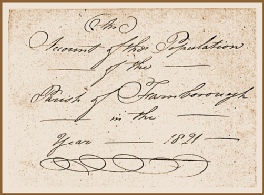



The first British census was taken in 1801, just a year after the Act of Parliament authorising its preparation. English statistician John Rickman, a Clerk to the House of Commons, is generally credited with the idea of introducing the ten-
Among the reasons which he gave to promote his idea were that it would ascertain the number of men eligible for conscription into the militia and of seamen available for defence, at this period of the Napoleonic wars. There were also fears that the growth in population would outstrip food production, leading to "the need to plan the production of corn and thus to know the number of people who had to be fed".
From 1801 to 1831, the census was the responsibility of the Overseers of the Poor and of the clergy; there is no indication on the Farnborough returns who the enumerator was. However, his arithmetic does not appear to have been perfect, 33 males under five years of age being recorded, but totalled as 32: however, the grand total given is correct at 179. As regards females, sixteen were recorded as being between 40 and 50 years of age, but the total was given as fourteen. This was not adjusted as with the males, so the grand total of 178 would appear to be two short if the numbers for the individual households are correct.
The recorded total of 357 (359 in reality?) was also subject to some inaccuracy when published. Lewis's Gazetteer of 1831 gives a figure of 356, while White's 1850 Directory of Warwickshire (p.719) has 350. Whatever the exact figure, it is considerably higher than the 1801 and 1811 populations noted on the reverse of the 1821 sheet, at 241 and 250 respectively (again, White has 214 for 1801). The 43% increase from 1811 to 1821 is double the county figure: in the same decade, the Warwickshire population as enumerated increased by 20.2%, to 274,392.
The 1821 census, taken on the night of Monday 28th May, was the first British population count to request information about ages, and just under half of the population proved to be under twenty. Unfortunately, most of these early censuses have disappeared, Farnborough being one of only about 300 parishes for which such records survive. As regards the village results, 185, or 52%, of the inhabitants were under 20, which means that the Farnborough statistics are close to country-
Of the 63 households recorded, by far the most populous was that of William Holbech, Esq. A twelfth of the population (30 souls) were recorded in residence at his seat, Farnborough Hall, the 21 females among these no doubt including a large number "below stairs". Exactly two thirds of the remaining households had between 4 and 7 members. The full results excluding the Hall are: 14 members/1 household; 10/4; 9/3; 8/1; 7/7; 6/9; 5/8; 4/17; 3/7; 2/3; 1/2. Of the householders whose area of work was stated, 28 were employed in agriculture and 16 were in trade.
The whole of the census was recorded on a large, single sheet and was scanned in three sections. On these pages, each of the three images is accompanied by a transcript. In addition there are transcripts with entries in alphabetical order by surname, and notes on the identity or possible identity of most of the villagers named. As an alternative to reading the information on line, it can be downloaded in various forms from the Downloads and links page.
 Census image 1
Names A-He
Names Ho-W
Image 3
Identity of householders
Image 2
Census image 1
Names A-He
Names Ho-W
Image 3
Identity of householders
Image 2
|
Introduction to the Census |
| 2 Sitemap |
| 3 Maps - main page |
| 4 Pre 1844 O.S. map Farnborough and vicinity |
| 5 Ordnance Survey 6" scale 1885/6 |
| 2 Accounts 1 - Feb-May 1758 |
| 3 Accounts 2 - May-Sept 1758 |
| 4 Acc 3 - Sept 1758-Feb 1759 |
| 5 Acc 4 - personal & place names |
| 6 Thomas Elkington's ancestry |